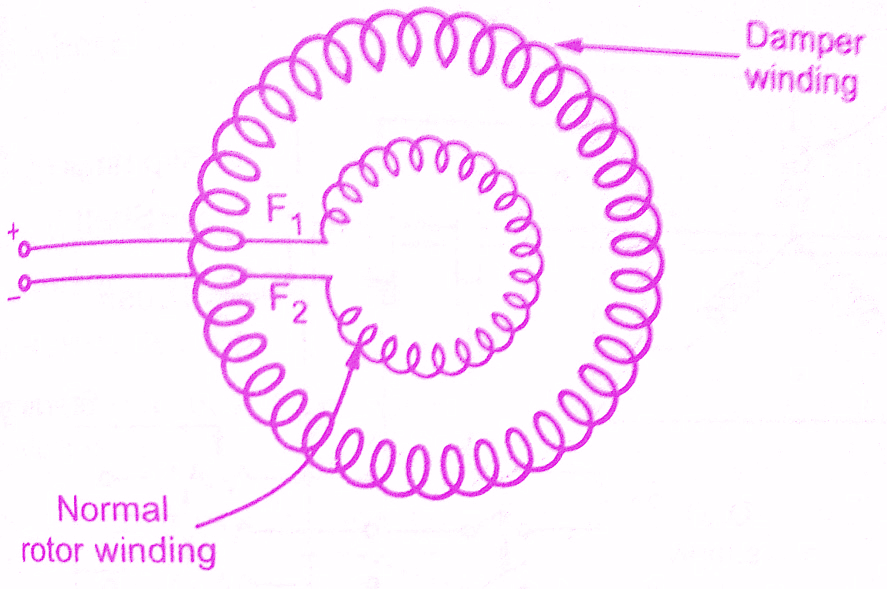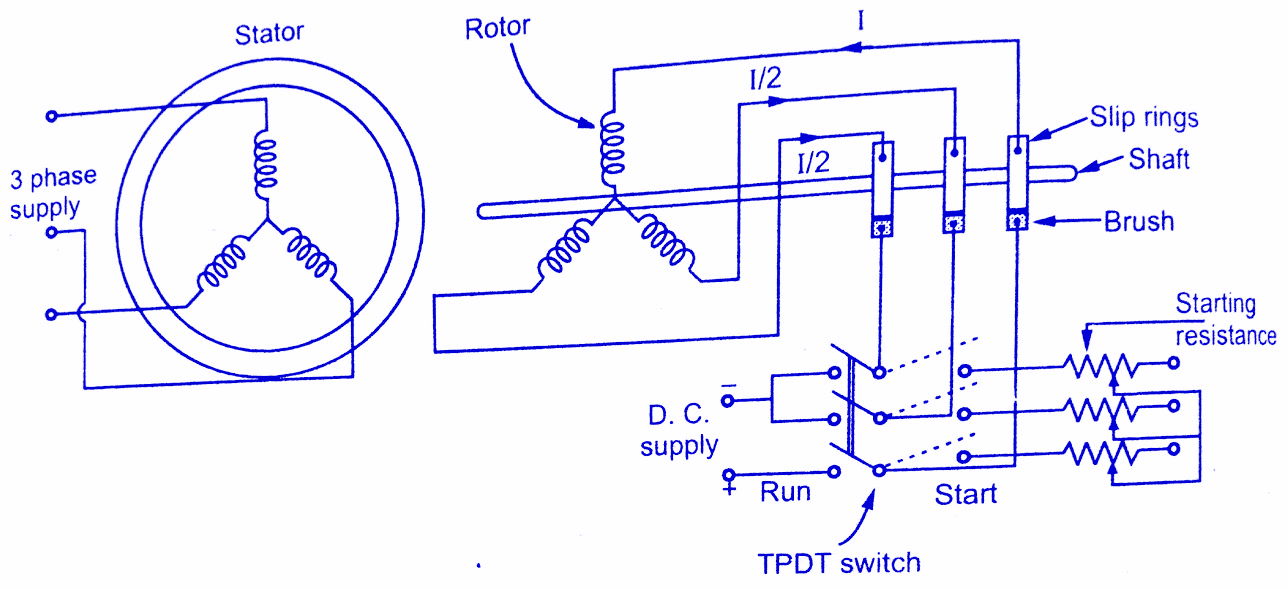General Method to start synchronous motor:
As we already know that synchronous Motor is not self-starting and we already discussed why the synchronous motor is not self-starting.So here is a general method to start synchronous motor.
1.Three phase winding is given a three phase ac supply.Now a rotating magnetic field is produced which is rotating at synchronous speed Ns rpm.
2.Now make the rotor to rotate in the direction of the rotating magnetic field at a speed very near to that of synchronous speed using some external equipment like a diesel engine.
3.Now switch on the dc supply given to the rotor so that rotor poles are produced.Now there are two fields one is rotating magnetic field produced by stator while the other is produced by the rotor which is physically rotated almost at the same speed as that of rotating magnetic field.
4. At a particular instant, both the fields are magnetically locked.The stator field pulls rotor field into synchronism.Now we can remove external device used to rotate rotor can be removed.But rotor will continue to rotate at the same speed as that of rotating magnetic field i.e. Ns due to magnetic locking.
Key Point: So the main point of this discussion is to start the synchronous motor, it needs some device to rotate the rotor at a speed very near or equal to the synchronous speed.
Must Read:
- Rotating Magnetic field(R.M.F) in Synchronous Machines
- Armature Windings in Alternator and Types of Armature Windings
Methods of starting Synchronous Motor:
We have to think about an alternative to rotate the rotor at a speed almost equal that of synchronous speed.So this can be possible by employing various methods to start the synchronous motor.The following are the different methods to start a synchronous motor.
1.Using Pony Motors
2.Using Damper Winding
3.As a slip ring Induction motor
4.Using Small dc machine coupled to it
1.Using pony Motors:
In this method, some external devices like small induction motor used to bring rotor near to synchronous motor.This external device is called Pony motor.
When the rotor attains synchronous speed, dc excitation to the rotor is switched on.After some time synchronism is developed and then pony motor is decoupled.Due to synchronism promoter continues to rotate as a synchronous motor.
2.Using damper winding:
In a synchronous motor, we have normal field winding and in addition to this additional winding consisting of copper bars is placed in the slots in the pole faces.These bars short-circuited with the help of end rings.This additional winding on the rotor is called damper winding.This winding as it is short-circuited, it acts like squirrel cage rotor winding of an induction motor.The schematic diagram of this damper winding is shown in the below figure.
Once the stator is excited by a three phase supply, the motor starts rotating as an induction motor at sub-synchronous speed. Then d.c. supply is given to the field winding.At a particular instant, motor gets pulled into synchronism and starts rotating at a synchronous speed. As the rotor rotates at synchronous speed, the relative motion between damper winding and the rotating magnetic field is zero.Hence when the motor is running as a synchronous motor, there cannot be any induced emf in the damper winding.
So damper winding is active only at the start, to run the motor as an induction motor at start.Afterwards, it is out of the circuit.As damper winding is short circuited and motor gets started as an induction motor, it draws high current at the start so induction motor starters like star-delta, autotransformer etc. used to start the synchronous motor as an induction motor.
3.As a Slip Ring Induction Motor:
The above method of starting synchronous motor as a squirrel cage induction motor does not provide high starting torque.So to achieve this, instead of shorting the damper Winding, it is designed to form a three phase star or delta connected winding.
The three ends of this winding are brought out through slip rings. An external rheostat then can be introduced in series with the rotor circuit. So when the stator is excited, the motor starts as a slip ring induction motor and due to resistance added in the rotor provides high starting torque.
The resistance is then gradually cut off, as motor gathers speed.When motor attains speed near synchronous, d.c. excitation is provided to the rotor, then motor gets pulled into synchronism and starts rotating at synchronous speed.The damper winding is shorted by shorting the slip rings.
The initial resistance added in the rotor not only provides high starting torque but also limits high inrush of starting current.Hence it acts as a rotor resistance starter.The synchronous motor started by this method is called a slip ring induction motor is shown in the below figure.
It can be observed from the above figure that the same three phase rotor winding acts as a normal rotor winding by shorting two of the phases. From the positive terminal, current ‘I’ flows in one of the phases, which divides into two other phases at start point as 1/2 through each, when the switch is thrown on d.c. supply side.
Must Read:
4.Using Small D.C. Machine:
Many times, large synchronous motors are provided with a coupled dc machine. This machine is used as a dc motor to rotate the synchronous motor at asynchronous speed.Then the excitation to the rotor is provided.Once the motor starts running as a synchronous motor, the same dc machine acts as a dc generator called exciter.The field of the synchronous motor is then excited by this exciter itself.
Conclusion:
Now here we discussed different methods of starting Synchronous Motors.You can download this post as pdf, ppt.
Comment below for any Queries.


Well explained thank you found this really helpful
Nice Blog. Really helpful. Thank you 😉
Thank you so much for your kind words! I’m glad that you found the blog helpful.
why there is different methods to start a synchronous machine?